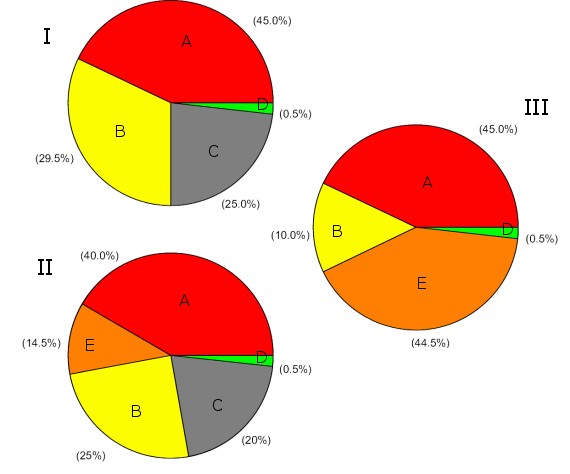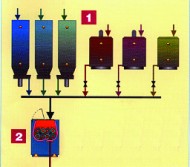|
Chocolate is a dispersion of fine solid particles (cocoa, sugar and milk powder) in cocoa butter, another fat, or a combination of cocoa butter and another fat. The composition of chocolate is roughly as follows (see Figure 5.1):
Figure 5.1: Composition of white chocolate, milk chocolate and plain chocolate

A = sugar
B = cocoa butter
C = milk powder
D = other ingredients
E = cocoa liquor
Other raw materials can be used, apart from the above ingredients. Table 5.1 includes a number of raw materials that are commonly used in one country, while often being ignored in another. In Switzerland, for instance, hazelnut paste is usually added as an ingredient; in the UK crumb is often included in the chocolate recipe; while in France bitter chocolate with a very high cocoa liquor content (up to 75%) is preferred.
(In the table, X stands for ‘Commonly used’ and O for ‘May be used’)
Table 5.1: Summary of usual and possible ingredients in different countries
|
Country |
NL / B |
NL / B |
NL / B |
D |
CH |
GB |
GB |
GB |
F |
|
Ingrediënts |
Milk choco-late |
Plain choco-late |
White choco-late |
Cream choco-late |
Milk choco-late |
Milk choco-late |
Plain choco-late |
White choco-late |
Plain choco-late |
| |
|
|
|
|
|
|
|
|
|
|
Sugar |
X |
X |
X |
X |
X |
X |
X |
X |
X |
|
Cocoa mass |
X |
X |
|
X |
X |
X |
X |
|
XX |
|
Cocoa butter |
X |
X |
X |
X |
X |
X |
X |
X |
X |
|
Cocoa powder |
|
O |
|
|
|
|
O |
|
O |
|
CBE |
O |
O |
O |
O |
O |
O |
O |
O |
O |
|
Milk powder –high fat |
X |
|
X |
X |
X |
X |
|
X |
|
|
Milk powder – low fat |
O |
|
O |
|
O |
O |
|
O |
|
|
Lactose |
O |
O |
O |
O |
O |
O |
O |
O |
O |
|
Milk fat |
O |
|
O |
O |
O |
O |
|
O |
|
|
Whey powder |
O |
|
O |
|
O |
O |
|
O |
|
|
Blok milkpowder |
O |
|
|
|
O |
X |
|
|
|
|
Crumb (see page 166) |
X |
O |
|
|
O |
X |
|
|
|
|
Cream powder |
O |
|
O |
O |
O |
O |
|
O |
|
|
E442 |
O |
O |
O |
X |
O |
X |
X |
O |
O |
|
Lecithin |
X |
X |
X |
X |
X |
X |
X |
X |
X |
|
PGPR (see page 170) |
O |
O |
O |
O |
O |
O |
O |
O |
O |
|
Vanillin |
O |
O |
O |
O |
O |
O |
O |
O |
O |
|
Vanilla |
O |
O |
O |
O |
O |
O |
O |
O |
O |
|
Hazel nut pasta |
|
|
|
|
X |
|
|
|
|
The table gives an idea of the raw materials that can be used, however, legislation regarding the composition of chocolate has to be taken into account when preparing a recipe (see chapter 8).
Chocolate manufacture is an industrial process, where a number of mechanical operations are needed to obtain the desired result. It normally includes four processing stages:
- thorough mixing of the raw materials;
- the refining of solid particles;
- thorough mixing of the refined solid particles and liquid fat
component(s) into a
homogenous product, both in terms of mouth feel and behaviour;
- further processing of the refined chocolate to obtain the desired end
flavour.
These four processes are discussed below.
Figure 5.2: Schematic view of a processing line for the production of chocolate mass (blending ingredients, pre-rolling, roll refining, conching)
 |
1 = ingredients
2 = mixer/kneader
3 = pre-roller (so called 2-roller)
4 = roller refiners
5 = conches
|  |
|
The production process from liquid chocolate to finished product can be a highly industrial one or a small-scale, traditional operation carried out by a confectioner. Paragraph 5.2 discusses this process.
Figure 5.3 Schematic process from ingredients to end product (Karlshamns)

|